Management Accounting Report: Tech Ltd Case Study Analysis
VerifiedAdded on 2020/07/23
|18
|5158
|119
Report
AI Summary
This report delves into the principles and applications of management accounting, using Tech Ltd, a manufacturer of electronic chargers, as a case study. It defines management accounting, contrasting it with financial accounting, and emphasizes its significance in managerial decision-making. The report explores various management accounting systems, including cost accounting, inventory management, and job costing, highlighting their advantages and disadvantages. It also examines the presentation of financial information through different managerial accounting reports, such as budget/performance variance analysis, job costing, and accounts receivable aging reports, and their roles in planning and control. The analysis includes preparing income statements using absorption and marginal costing methods, as well as presenting and evaluating different types of budgets, their preparation processes, and pricing methods. The report concludes by comparing how different business units adapt management accounting tools to address specific problems, offering a comprehensive overview of the subject matter.
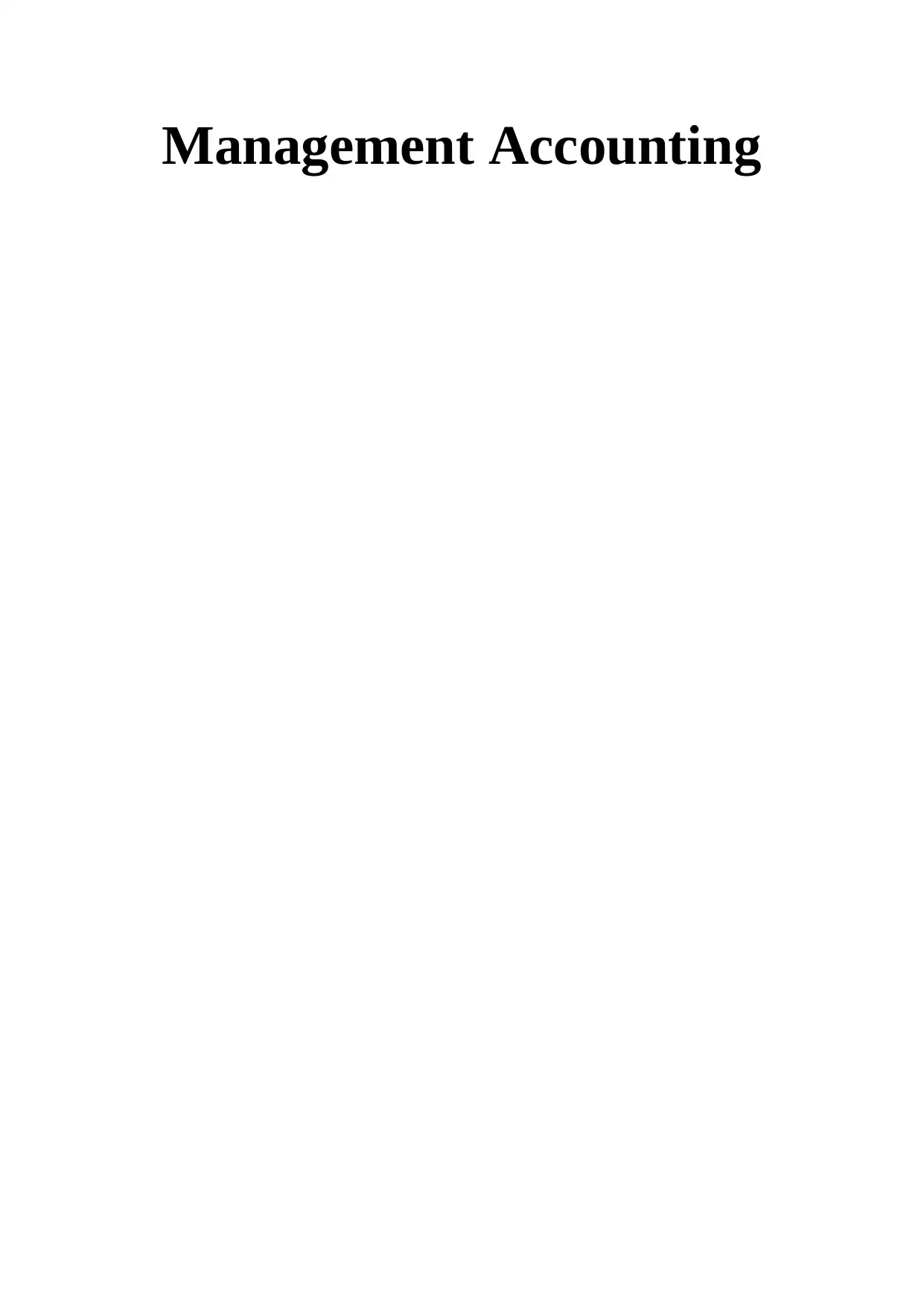
Management Accounting
Paraphrase This Document
Need a fresh take? Get an instant paraphrase of this document with our AI Paraphraser
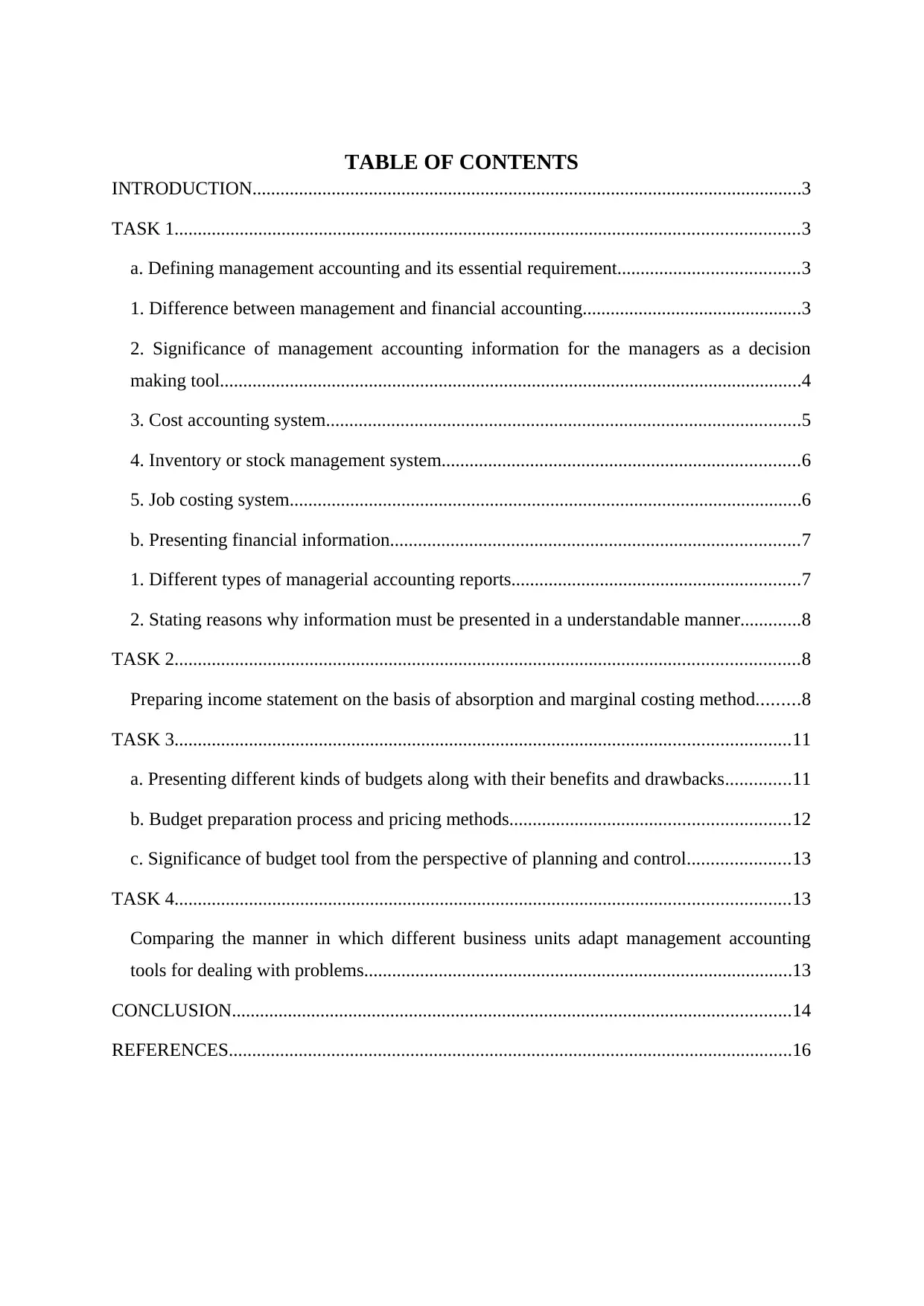
TABLE OF CONTENTS
INTRODUCTION......................................................................................................................3
TASK 1......................................................................................................................................3
a. Defining management accounting and its essential requirement.......................................3
1. Difference between management and financial accounting...............................................3
2. Significance of management accounting information for the managers as a decision
making tool.............................................................................................................................4
3. Cost accounting system......................................................................................................5
4. Inventory or stock management system.............................................................................6
5. Job costing system..............................................................................................................6
b. Presenting financial information........................................................................................7
1. Different types of managerial accounting reports..............................................................7
2. Stating reasons why information must be presented in a understandable manner.............8
TASK 2......................................................................................................................................8
Preparing income statement on the basis of absorption and marginal costing method.........8
TASK 3....................................................................................................................................11
a. Presenting different kinds of budgets along with their benefits and drawbacks..............11
b. Budget preparation process and pricing methods............................................................12
c. Significance of budget tool from the perspective of planning and control......................13
TASK 4....................................................................................................................................13
Comparing the manner in which different business units adapt management accounting
tools for dealing with problems............................................................................................13
CONCLUSION........................................................................................................................14
REFERENCES.........................................................................................................................16
INTRODUCTION......................................................................................................................3
TASK 1......................................................................................................................................3
a. Defining management accounting and its essential requirement.......................................3
1. Difference between management and financial accounting...............................................3
2. Significance of management accounting information for the managers as a decision
making tool.............................................................................................................................4
3. Cost accounting system......................................................................................................5
4. Inventory or stock management system.............................................................................6
5. Job costing system..............................................................................................................6
b. Presenting financial information........................................................................................7
1. Different types of managerial accounting reports..............................................................7
2. Stating reasons why information must be presented in a understandable manner.............8
TASK 2......................................................................................................................................8
Preparing income statement on the basis of absorption and marginal costing method.........8
TASK 3....................................................................................................................................11
a. Presenting different kinds of budgets along with their benefits and drawbacks..............11
b. Budget preparation process and pricing methods............................................................12
c. Significance of budget tool from the perspective of planning and control......................13
TASK 4....................................................................................................................................13
Comparing the manner in which different business units adapt management accounting
tools for dealing with problems............................................................................................13
CONCLUSION........................................................................................................................14
REFERENCES.........................................................................................................................16
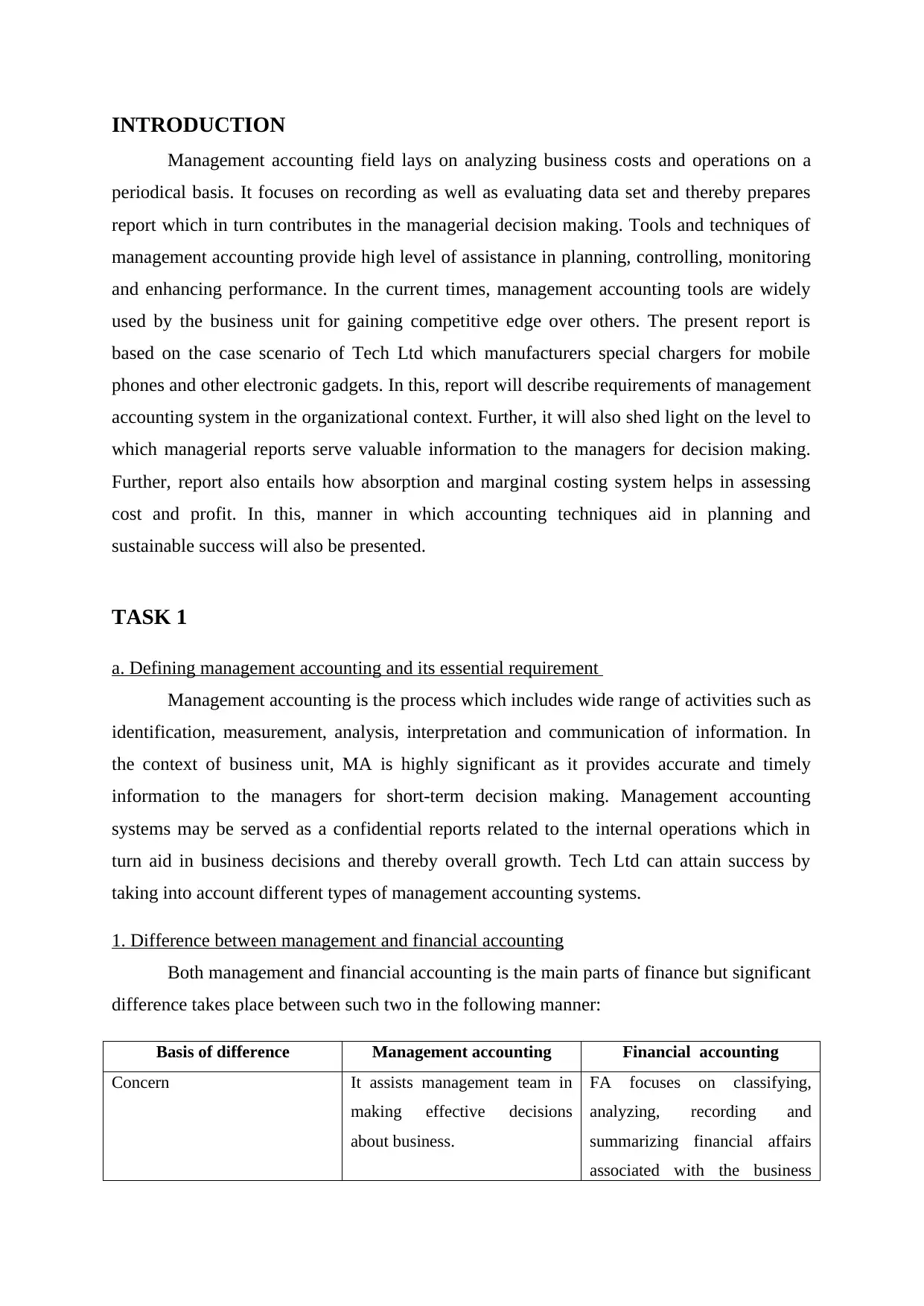
INTRODUCTION
Management accounting field lays on analyzing business costs and operations on a
periodical basis. It focuses on recording as well as evaluating data set and thereby prepares
report which in turn contributes in the managerial decision making. Tools and techniques of
management accounting provide high level of assistance in planning, controlling, monitoring
and enhancing performance. In the current times, management accounting tools are widely
used by the business unit for gaining competitive edge over others. The present report is
based on the case scenario of Tech Ltd which manufacturers special chargers for mobile
phones and other electronic gadgets. In this, report will describe requirements of management
accounting system in the organizational context. Further, it will also shed light on the level to
which managerial reports serve valuable information to the managers for decision making.
Further, report also entails how absorption and marginal costing system helps in assessing
cost and profit. In this, manner in which accounting techniques aid in planning and
sustainable success will also be presented.
TASK 1
a. Defining management accounting and its essential requirement
Management accounting is the process which includes wide range of activities such as
identification, measurement, analysis, interpretation and communication of information. In
the context of business unit, MA is highly significant as it provides accurate and timely
information to the managers for short-term decision making. Management accounting
systems may be served as a confidential reports related to the internal operations which in
turn aid in business decisions and thereby overall growth. Tech Ltd can attain success by
taking into account different types of management accounting systems.
1. Difference between management and financial accounting
Both management and financial accounting is the main parts of finance but significant
difference takes place between such two in the following manner:
Basis of difference Management accounting Financial accounting
Concern It assists management team in
making effective decisions
about business.
FA focuses on classifying,
analyzing, recording and
summarizing financial affairs
associated with the business
Management accounting field lays on analyzing business costs and operations on a
periodical basis. It focuses on recording as well as evaluating data set and thereby prepares
report which in turn contributes in the managerial decision making. Tools and techniques of
management accounting provide high level of assistance in planning, controlling, monitoring
and enhancing performance. In the current times, management accounting tools are widely
used by the business unit for gaining competitive edge over others. The present report is
based on the case scenario of Tech Ltd which manufacturers special chargers for mobile
phones and other electronic gadgets. In this, report will describe requirements of management
accounting system in the organizational context. Further, it will also shed light on the level to
which managerial reports serve valuable information to the managers for decision making.
Further, report also entails how absorption and marginal costing system helps in assessing
cost and profit. In this, manner in which accounting techniques aid in planning and
sustainable success will also be presented.
TASK 1
a. Defining management accounting and its essential requirement
Management accounting is the process which includes wide range of activities such as
identification, measurement, analysis, interpretation and communication of information. In
the context of business unit, MA is highly significant as it provides accurate and timely
information to the managers for short-term decision making. Management accounting
systems may be served as a confidential reports related to the internal operations which in
turn aid in business decisions and thereby overall growth. Tech Ltd can attain success by
taking into account different types of management accounting systems.
1. Difference between management and financial accounting
Both management and financial accounting is the main parts of finance but significant
difference takes place between such two in the following manner:
Basis of difference Management accounting Financial accounting
Concern It assists management team in
making effective decisions
about business.
FA focuses on classifying,
analyzing, recording and
summarizing financial affairs
associated with the business
⊘ This is a preview!⊘
Do you want full access?
Subscribe today to unlock all pages.

Trusted by 1+ million students worldwide
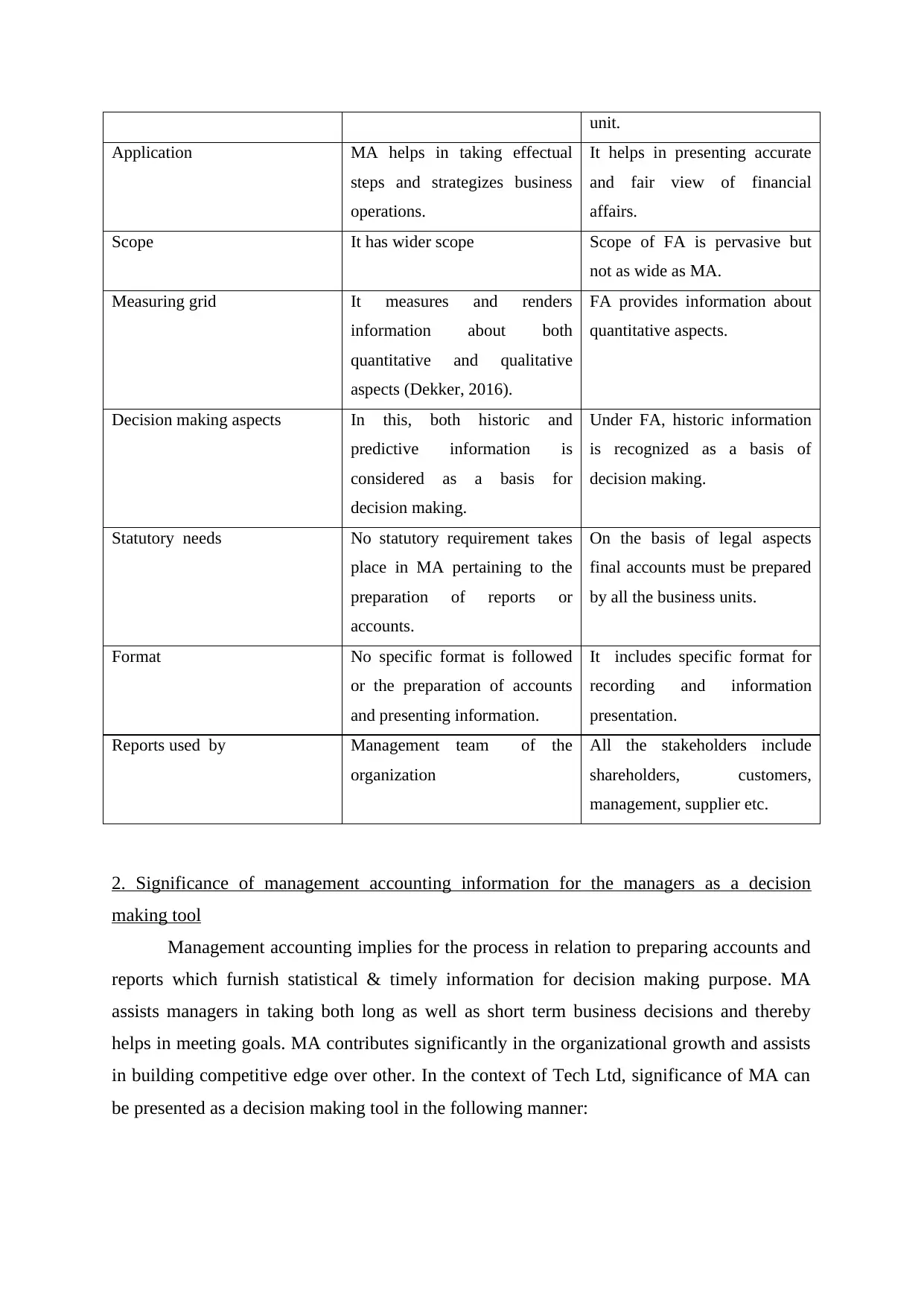
unit.
Application MA helps in taking effectual
steps and strategizes business
operations.
It helps in presenting accurate
and fair view of financial
affairs.
Scope It has wider scope Scope of FA is pervasive but
not as wide as MA.
Measuring grid It measures and renders
information about both
quantitative and qualitative
aspects (Dekker, 2016).
FA provides information about
quantitative aspects.
Decision making aspects In this, both historic and
predictive information is
considered as a basis for
decision making.
Under FA, historic information
is recognized as a basis of
decision making.
Statutory needs No statutory requirement takes
place in MA pertaining to the
preparation of reports or
accounts.
On the basis of legal aspects
final accounts must be prepared
by all the business units.
Format No specific format is followed
or the preparation of accounts
and presenting information.
It includes specific format for
recording and information
presentation.
Reports used by Management team of the
organization
All the stakeholders include
shareholders, customers,
management, supplier etc.
2. Significance of management accounting information for the managers as a decision
making tool
Management accounting implies for the process in relation to preparing accounts and
reports which furnish statistical & timely information for decision making purpose. MA
assists managers in taking both long as well as short term business decisions and thereby
helps in meeting goals. MA contributes significantly in the organizational growth and assists
in building competitive edge over other. In the context of Tech Ltd, significance of MA can
be presented as a decision making tool in the following manner:
Application MA helps in taking effectual
steps and strategizes business
operations.
It helps in presenting accurate
and fair view of financial
affairs.
Scope It has wider scope Scope of FA is pervasive but
not as wide as MA.
Measuring grid It measures and renders
information about both
quantitative and qualitative
aspects (Dekker, 2016).
FA provides information about
quantitative aspects.
Decision making aspects In this, both historic and
predictive information is
considered as a basis for
decision making.
Under FA, historic information
is recognized as a basis of
decision making.
Statutory needs No statutory requirement takes
place in MA pertaining to the
preparation of reports or
accounts.
On the basis of legal aspects
final accounts must be prepared
by all the business units.
Format No specific format is followed
or the preparation of accounts
and presenting information.
It includes specific format for
recording and information
presentation.
Reports used by Management team of the
organization
All the stakeholders include
shareholders, customers,
management, supplier etc.
2. Significance of management accounting information for the managers as a decision
making tool
Management accounting implies for the process in relation to preparing accounts and
reports which furnish statistical & timely information for decision making purpose. MA
assists managers in taking both long as well as short term business decisions and thereby
helps in meeting goals. MA contributes significantly in the organizational growth and assists
in building competitive edge over other. In the context of Tech Ltd, significance of MA can
be presented as a decision making tool in the following manner:
Paraphrase This Document
Need a fresh take? Get an instant paraphrase of this document with our AI Paraphraser
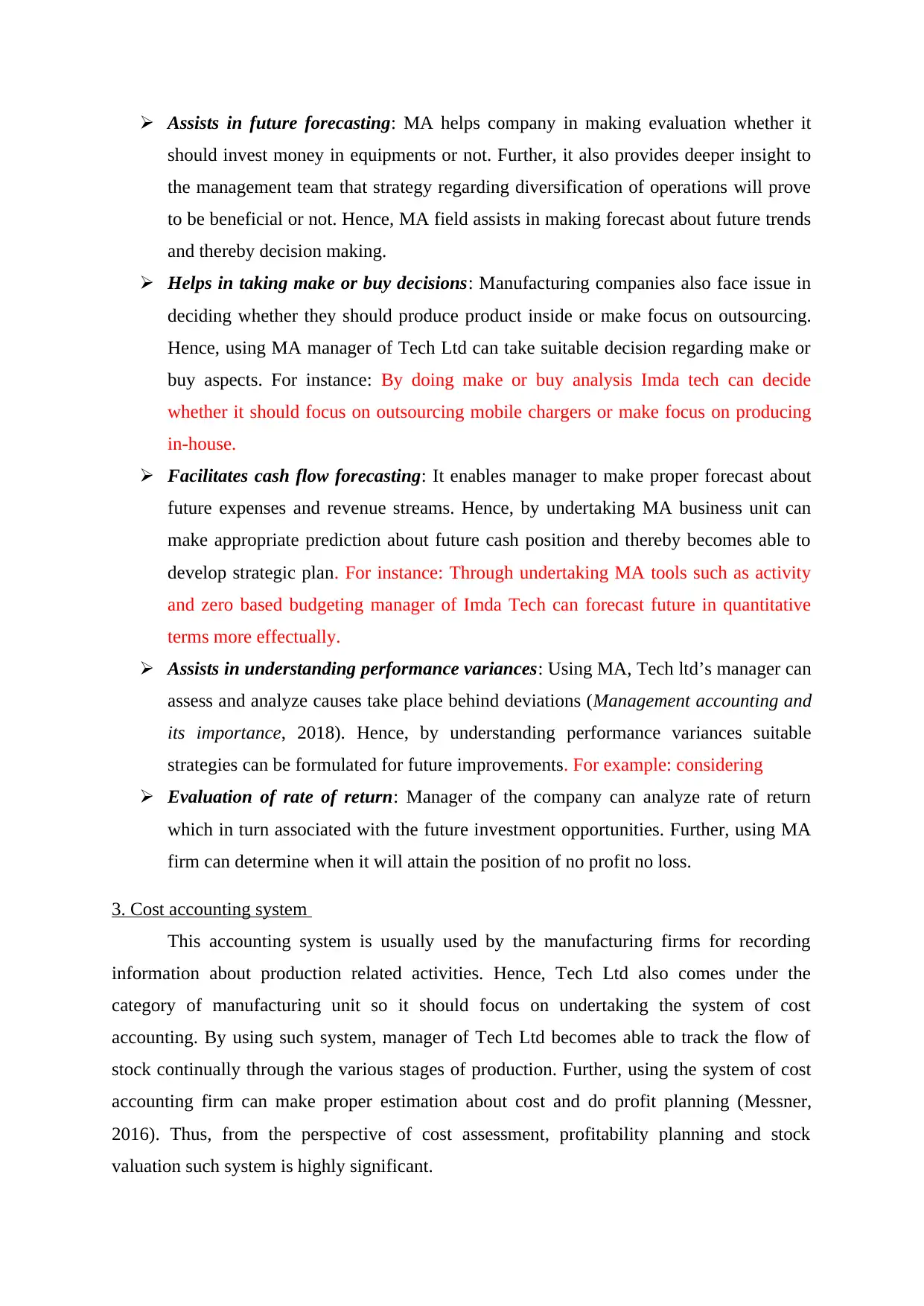
Assists in future forecasting: MA helps company in making evaluation whether it
should invest money in equipments or not. Further, it also provides deeper insight to
the management team that strategy regarding diversification of operations will prove
to be beneficial or not. Hence, MA field assists in making forecast about future trends
and thereby decision making.
Helps in taking make or buy decisions: Manufacturing companies also face issue in
deciding whether they should produce product inside or make focus on outsourcing.
Hence, using MA manager of Tech Ltd can take suitable decision regarding make or
buy aspects. For instance: By doing make or buy analysis Imda tech can decide
whether it should focus on outsourcing mobile chargers or make focus on producing
in-house.
Facilitates cash flow forecasting: It enables manager to make proper forecast about
future expenses and revenue streams. Hence, by undertaking MA business unit can
make appropriate prediction about future cash position and thereby becomes able to
develop strategic plan. For instance: Through undertaking MA tools such as activity
and zero based budgeting manager of Imda Tech can forecast future in quantitative
terms more effectually.
Assists in understanding performance variances: Using MA, Tech ltd’s manager can
assess and analyze causes take place behind deviations (Management accounting and
its importance, 2018). Hence, by understanding performance variances suitable
strategies can be formulated for future improvements. For example: considering
Evaluation of rate of return: Manager of the company can analyze rate of return
which in turn associated with the future investment opportunities. Further, using MA
firm can determine when it will attain the position of no profit no loss.
3. Cost accounting system
This accounting system is usually used by the manufacturing firms for recording
information about production related activities. Hence, Tech Ltd also comes under the
category of manufacturing unit so it should focus on undertaking the system of cost
accounting. By using such system, manager of Tech Ltd becomes able to track the flow of
stock continually through the various stages of production. Further, using the system of cost
accounting firm can make proper estimation about cost and do profit planning (Messner,
2016). Thus, from the perspective of cost assessment, profitability planning and stock
valuation such system is highly significant.
should invest money in equipments or not. Further, it also provides deeper insight to
the management team that strategy regarding diversification of operations will prove
to be beneficial or not. Hence, MA field assists in making forecast about future trends
and thereby decision making.
Helps in taking make or buy decisions: Manufacturing companies also face issue in
deciding whether they should produce product inside or make focus on outsourcing.
Hence, using MA manager of Tech Ltd can take suitable decision regarding make or
buy aspects. For instance: By doing make or buy analysis Imda tech can decide
whether it should focus on outsourcing mobile chargers or make focus on producing
in-house.
Facilitates cash flow forecasting: It enables manager to make proper forecast about
future expenses and revenue streams. Hence, by undertaking MA business unit can
make appropriate prediction about future cash position and thereby becomes able to
develop strategic plan. For instance: Through undertaking MA tools such as activity
and zero based budgeting manager of Imda Tech can forecast future in quantitative
terms more effectually.
Assists in understanding performance variances: Using MA, Tech ltd’s manager can
assess and analyze causes take place behind deviations (Management accounting and
its importance, 2018). Hence, by understanding performance variances suitable
strategies can be formulated for future improvements. For example: considering
Evaluation of rate of return: Manager of the company can analyze rate of return
which in turn associated with the future investment opportunities. Further, using MA
firm can determine when it will attain the position of no profit no loss.
3. Cost accounting system
This accounting system is usually used by the manufacturing firms for recording
information about production related activities. Hence, Tech Ltd also comes under the
category of manufacturing unit so it should focus on undertaking the system of cost
accounting. By using such system, manager of Tech Ltd becomes able to track the flow of
stock continually through the various stages of production. Further, using the system of cost
accounting firm can make proper estimation about cost and do profit planning (Messner,
2016). Thus, from the perspective of cost assessment, profitability planning and stock
valuation such system is highly significant.
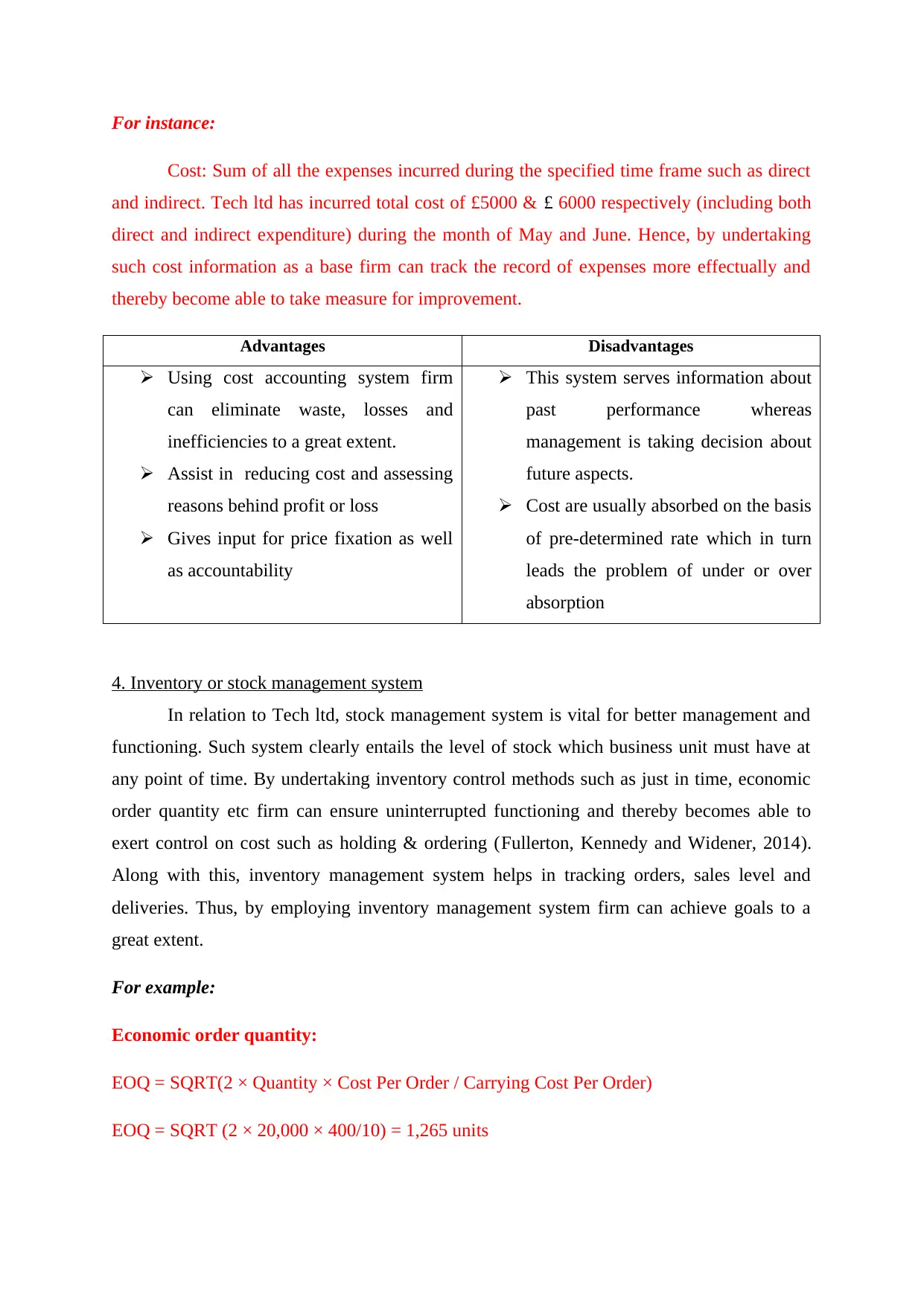
For instance:
Cost: Sum of all the expenses incurred during the specified time frame such as direct
and indirect. Tech ltd has incurred total cost of £5000 & £ 6000 respectively (including both
direct and indirect expenditure) during the month of May and June. Hence, by undertaking
such cost information as a base firm can track the record of expenses more effectually and
thereby become able to take measure for improvement.
Advantages Disadvantages
Using cost accounting system firm
can eliminate waste, losses and
inefficiencies to a great extent.
Assist in reducing cost and assessing
reasons behind profit or loss
Gives input for price fixation as well
as accountability
This system serves information about
past performance whereas
management is taking decision about
future aspects.
Cost are usually absorbed on the basis
of pre-determined rate which in turn
leads the problem of under or over
absorption
4. Inventory or stock management system
In relation to Tech ltd, stock management system is vital for better management and
functioning. Such system clearly entails the level of stock which business unit must have at
any point of time. By undertaking inventory control methods such as just in time, economic
order quantity etc firm can ensure uninterrupted functioning and thereby becomes able to
exert control on cost such as holding & ordering (Fullerton, Kennedy and Widener, 2014).
Along with this, inventory management system helps in tracking orders, sales level and
deliveries. Thus, by employing inventory management system firm can achieve goals to a
great extent.
For example:
Economic order quantity:
EOQ = SQRT(2 × Quantity × Cost Per Order / Carrying Cost Per Order)
EOQ = SQRT (2 × 20,000 × 400/10) = 1,265 units
Cost: Sum of all the expenses incurred during the specified time frame such as direct
and indirect. Tech ltd has incurred total cost of £5000 & £ 6000 respectively (including both
direct and indirect expenditure) during the month of May and June. Hence, by undertaking
such cost information as a base firm can track the record of expenses more effectually and
thereby become able to take measure for improvement.
Advantages Disadvantages
Using cost accounting system firm
can eliminate waste, losses and
inefficiencies to a great extent.
Assist in reducing cost and assessing
reasons behind profit or loss
Gives input for price fixation as well
as accountability
This system serves information about
past performance whereas
management is taking decision about
future aspects.
Cost are usually absorbed on the basis
of pre-determined rate which in turn
leads the problem of under or over
absorption
4. Inventory or stock management system
In relation to Tech ltd, stock management system is vital for better management and
functioning. Such system clearly entails the level of stock which business unit must have at
any point of time. By undertaking inventory control methods such as just in time, economic
order quantity etc firm can ensure uninterrupted functioning and thereby becomes able to
exert control on cost such as holding & ordering (Fullerton, Kennedy and Widener, 2014).
Along with this, inventory management system helps in tracking orders, sales level and
deliveries. Thus, by employing inventory management system firm can achieve goals to a
great extent.
For example:
Economic order quantity:
EOQ = SQRT(2 × Quantity × Cost Per Order / Carrying Cost Per Order)
EOQ = SQRT (2 × 20,000 × 400/10) = 1,265 units
⊘ This is a preview!⊘
Do you want full access?
Subscribe today to unlock all pages.

Trusted by 1+ million students worldwide
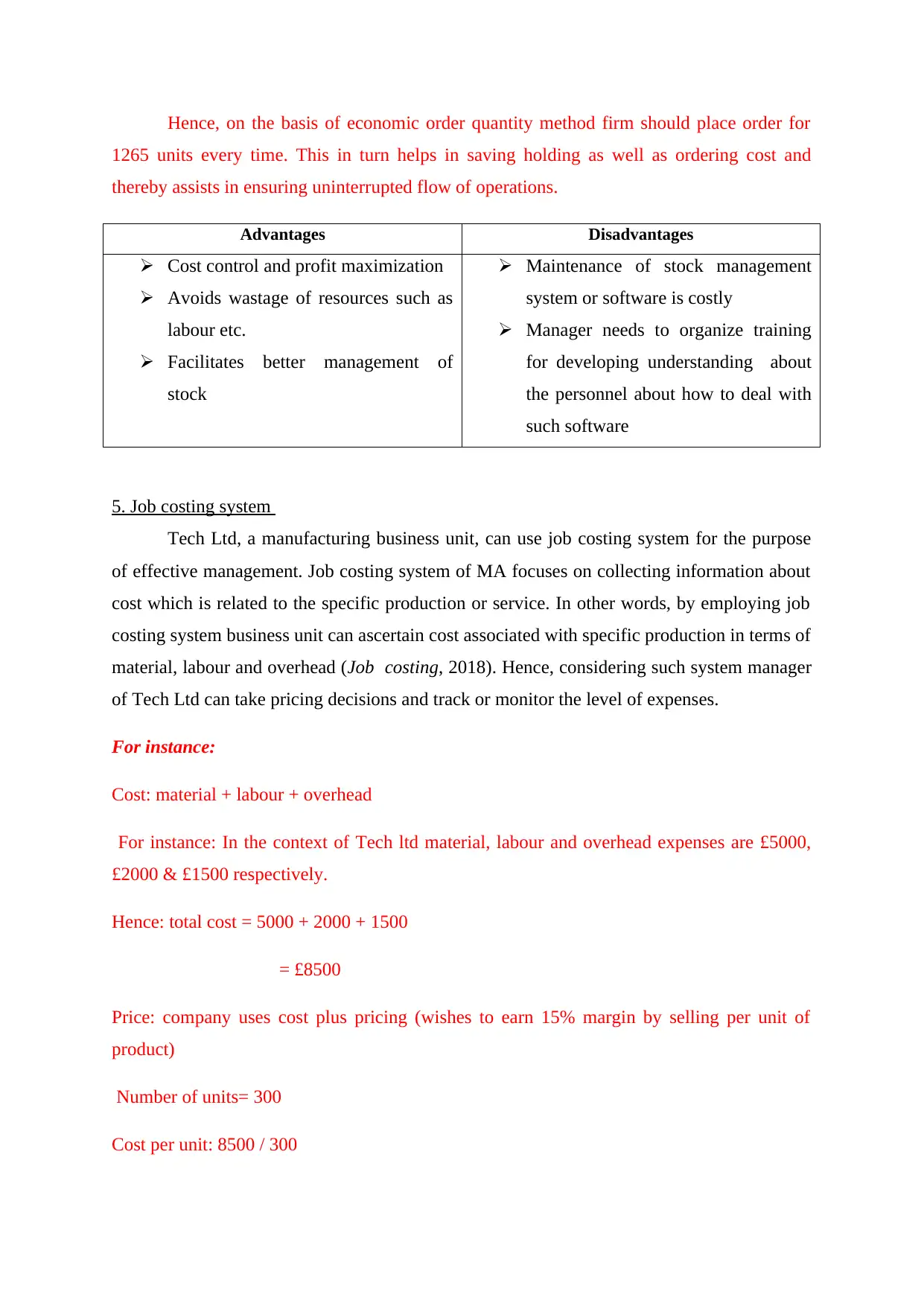
Hence, on the basis of economic order quantity method firm should place order for
1265 units every time. This in turn helps in saving holding as well as ordering cost and
thereby assists in ensuring uninterrupted flow of operations.
Advantages Disadvantages
Cost control and profit maximization
Avoids wastage of resources such as
labour etc.
Facilitates better management of
stock
Maintenance of stock management
system or software is costly
Manager needs to organize training
for developing understanding about
the personnel about how to deal with
such software
5. Job costing system
Tech Ltd, a manufacturing business unit, can use job costing system for the purpose
of effective management. Job costing system of MA focuses on collecting information about
cost which is related to the specific production or service. In other words, by employing job
costing system business unit can ascertain cost associated with specific production in terms of
material, labour and overhead (Job costing, 2018). Hence, considering such system manager
of Tech Ltd can take pricing decisions and track or monitor the level of expenses.
For instance:
Cost: material + labour + overhead
For instance: In the context of Tech ltd material, labour and overhead expenses are £5000,
£2000 & £1500 respectively.
Hence: total cost = 5000 + 2000 + 1500
= £8500
Price: company uses cost plus pricing (wishes to earn 15% margin by selling per unit of
product)
Number of units= 300
Cost per unit: 8500 / 300
1265 units every time. This in turn helps in saving holding as well as ordering cost and
thereby assists in ensuring uninterrupted flow of operations.
Advantages Disadvantages
Cost control and profit maximization
Avoids wastage of resources such as
labour etc.
Facilitates better management of
stock
Maintenance of stock management
system or software is costly
Manager needs to organize training
for developing understanding about
the personnel about how to deal with
such software
5. Job costing system
Tech Ltd, a manufacturing business unit, can use job costing system for the purpose
of effective management. Job costing system of MA focuses on collecting information about
cost which is related to the specific production or service. In other words, by employing job
costing system business unit can ascertain cost associated with specific production in terms of
material, labour and overhead (Job costing, 2018). Hence, considering such system manager
of Tech Ltd can take pricing decisions and track or monitor the level of expenses.
For instance:
Cost: material + labour + overhead
For instance: In the context of Tech ltd material, labour and overhead expenses are £5000,
£2000 & £1500 respectively.
Hence: total cost = 5000 + 2000 + 1500
= £8500
Price: company uses cost plus pricing (wishes to earn 15% margin by selling per unit of
product)
Number of units= 300
Cost per unit: 8500 / 300
Paraphrase This Document
Need a fresh take? Get an instant paraphrase of this document with our AI Paraphraser
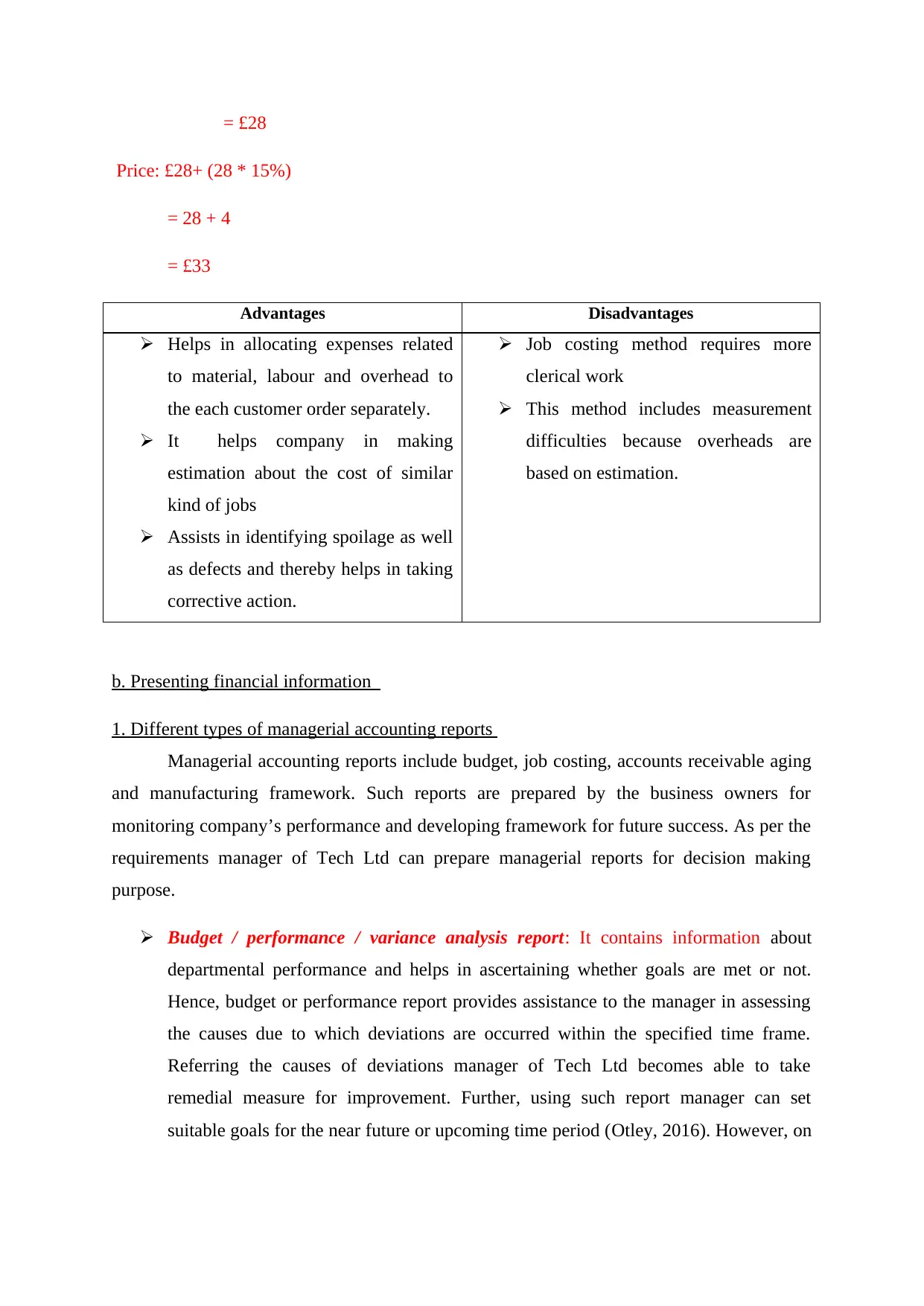
= £28
Price: £28+ (28 * 15%)
= 28 + 4
= £33
Advantages Disadvantages
Helps in allocating expenses related
to material, labour and overhead to
the each customer order separately.
It helps company in making
estimation about the cost of similar
kind of jobs
Assists in identifying spoilage as well
as defects and thereby helps in taking
corrective action.
Job costing method requires more
clerical work
This method includes measurement
difficulties because overheads are
based on estimation.
b. Presenting financial information
1. Different types of managerial accounting reports
Managerial accounting reports include budget, job costing, accounts receivable aging
and manufacturing framework. Such reports are prepared by the business owners for
monitoring company’s performance and developing framework for future success. As per the
requirements manager of Tech Ltd can prepare managerial reports for decision making
purpose.
Budget / performance / variance analysis report: It contains information about
departmental performance and helps in ascertaining whether goals are met or not.
Hence, budget or performance report provides assistance to the manager in assessing
the causes due to which deviations are occurred within the specified time frame.
Referring the causes of deviations manager of Tech Ltd becomes able to take
remedial measure for improvement. Further, using such report manager can set
suitable goals for the near future or upcoming time period (Otley, 2016). However, on
Price: £28+ (28 * 15%)
= 28 + 4
= £33
Advantages Disadvantages
Helps in allocating expenses related
to material, labour and overhead to
the each customer order separately.
It helps company in making
estimation about the cost of similar
kind of jobs
Assists in identifying spoilage as well
as defects and thereby helps in taking
corrective action.
Job costing method requires more
clerical work
This method includes measurement
difficulties because overheads are
based on estimation.
b. Presenting financial information
1. Different types of managerial accounting reports
Managerial accounting reports include budget, job costing, accounts receivable aging
and manufacturing framework. Such reports are prepared by the business owners for
monitoring company’s performance and developing framework for future success. As per the
requirements manager of Tech Ltd can prepare managerial reports for decision making
purpose.
Budget / performance / variance analysis report: It contains information about
departmental performance and helps in ascertaining whether goals are met or not.
Hence, budget or performance report provides assistance to the manager in assessing
the causes due to which deviations are occurred within the specified time frame.
Referring the causes of deviations manager of Tech Ltd becomes able to take
remedial measure for improvement. Further, using such report manager can set
suitable goals for the near future or upcoming time period (Otley, 2016). However, on
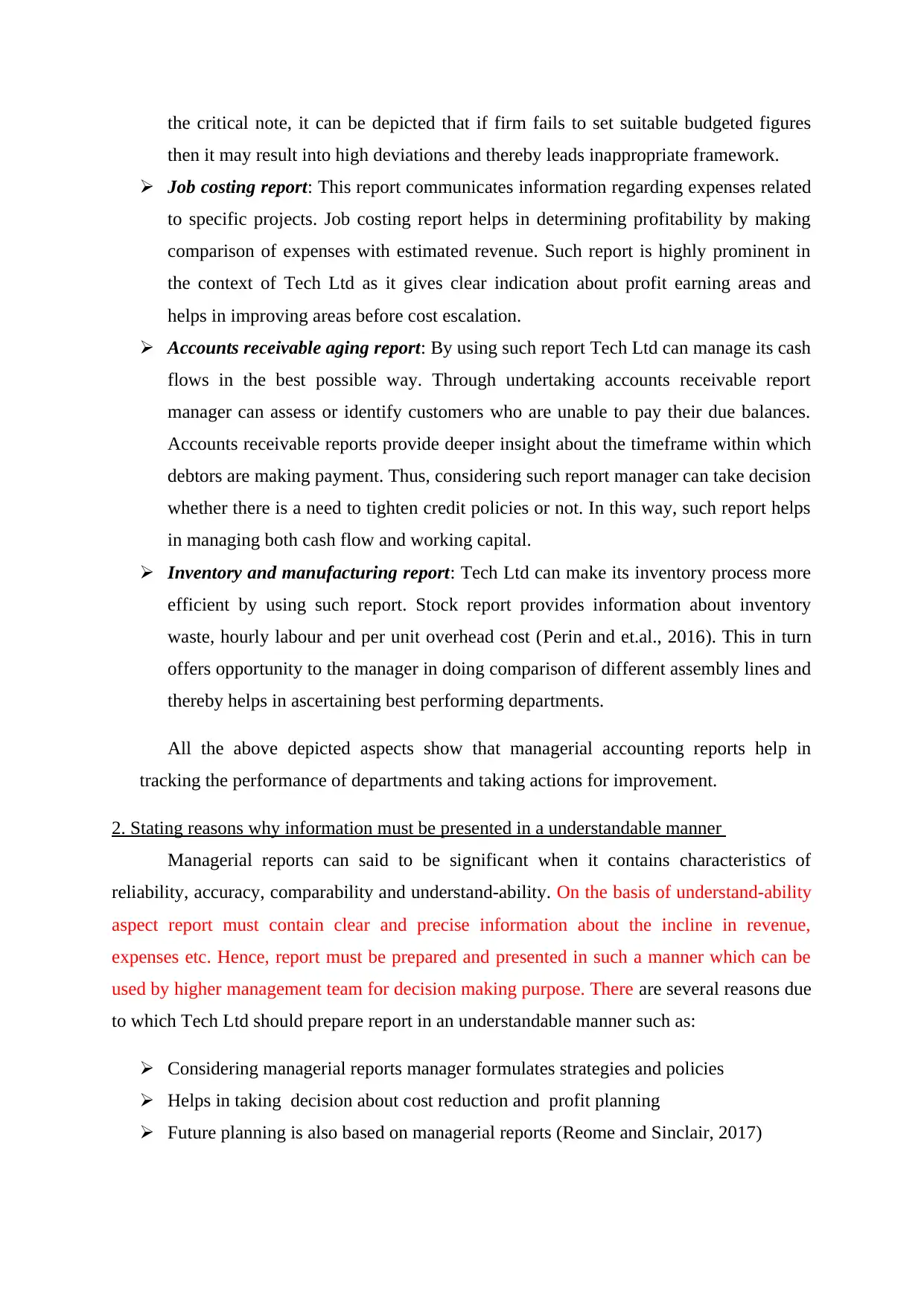
the critical note, it can be depicted that if firm fails to set suitable budgeted figures
then it may result into high deviations and thereby leads inappropriate framework.
Job costing report: This report communicates information regarding expenses related
to specific projects. Job costing report helps in determining profitability by making
comparison of expenses with estimated revenue. Such report is highly prominent in
the context of Tech Ltd as it gives clear indication about profit earning areas and
helps in improving areas before cost escalation.
Accounts receivable aging report: By using such report Tech Ltd can manage its cash
flows in the best possible way. Through undertaking accounts receivable report
manager can assess or identify customers who are unable to pay their due balances.
Accounts receivable reports provide deeper insight about the timeframe within which
debtors are making payment. Thus, considering such report manager can take decision
whether there is a need to tighten credit policies or not. In this way, such report helps
in managing both cash flow and working capital.
Inventory and manufacturing report: Tech Ltd can make its inventory process more
efficient by using such report. Stock report provides information about inventory
waste, hourly labour and per unit overhead cost (Perin and et.al., 2016). This in turn
offers opportunity to the manager in doing comparison of different assembly lines and
thereby helps in ascertaining best performing departments.
All the above depicted aspects show that managerial accounting reports help in
tracking the performance of departments and taking actions for improvement.
2. Stating reasons why information must be presented in a understandable manner
Managerial reports can said to be significant when it contains characteristics of
reliability, accuracy, comparability and understand-ability. On the basis of understand-ability
aspect report must contain clear and precise information about the incline in revenue,
expenses etc. Hence, report must be prepared and presented in such a manner which can be
used by higher management team for decision making purpose. There are several reasons due
to which Tech Ltd should prepare report in an understandable manner such as:
Considering managerial reports manager formulates strategies and policies
Helps in taking decision about cost reduction and profit planning
Future planning is also based on managerial reports (Reome and Sinclair, 2017)
then it may result into high deviations and thereby leads inappropriate framework.
Job costing report: This report communicates information regarding expenses related
to specific projects. Job costing report helps in determining profitability by making
comparison of expenses with estimated revenue. Such report is highly prominent in
the context of Tech Ltd as it gives clear indication about profit earning areas and
helps in improving areas before cost escalation.
Accounts receivable aging report: By using such report Tech Ltd can manage its cash
flows in the best possible way. Through undertaking accounts receivable report
manager can assess or identify customers who are unable to pay their due balances.
Accounts receivable reports provide deeper insight about the timeframe within which
debtors are making payment. Thus, considering such report manager can take decision
whether there is a need to tighten credit policies or not. In this way, such report helps
in managing both cash flow and working capital.
Inventory and manufacturing report: Tech Ltd can make its inventory process more
efficient by using such report. Stock report provides information about inventory
waste, hourly labour and per unit overhead cost (Perin and et.al., 2016). This in turn
offers opportunity to the manager in doing comparison of different assembly lines and
thereby helps in ascertaining best performing departments.
All the above depicted aspects show that managerial accounting reports help in
tracking the performance of departments and taking actions for improvement.
2. Stating reasons why information must be presented in a understandable manner
Managerial reports can said to be significant when it contains characteristics of
reliability, accuracy, comparability and understand-ability. On the basis of understand-ability
aspect report must contain clear and precise information about the incline in revenue,
expenses etc. Hence, report must be prepared and presented in such a manner which can be
used by higher management team for decision making purpose. There are several reasons due
to which Tech Ltd should prepare report in an understandable manner such as:
Considering managerial reports manager formulates strategies and policies
Helps in taking decision about cost reduction and profit planning
Future planning is also based on managerial reports (Reome and Sinclair, 2017)
⊘ This is a preview!⊘
Do you want full access?
Subscribe today to unlock all pages.

Trusted by 1+ million students worldwide
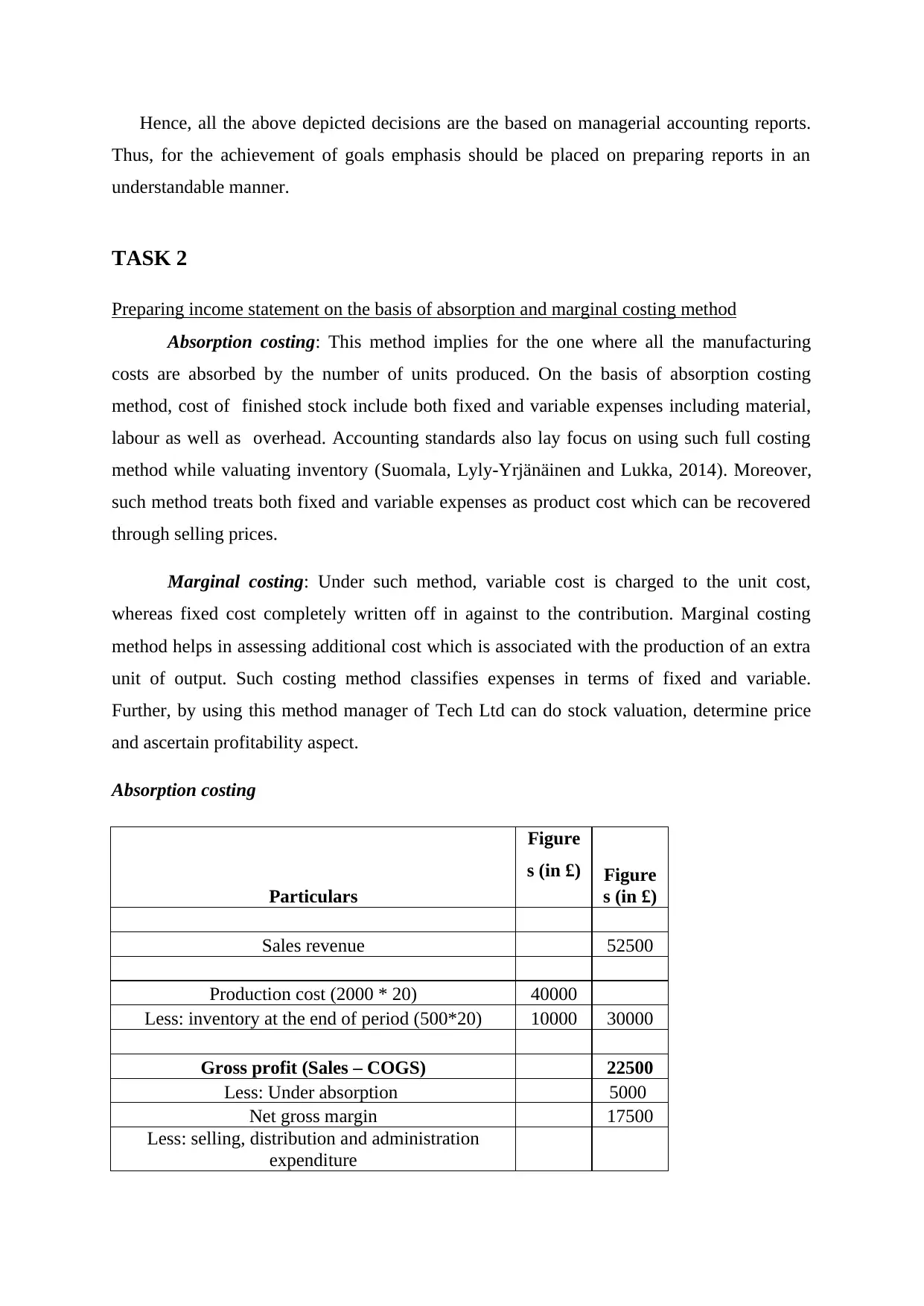
Hence, all the above depicted decisions are the based on managerial accounting reports.
Thus, for the achievement of goals emphasis should be placed on preparing reports in an
understandable manner.
TASK 2
Preparing income statement on the basis of absorption and marginal costing method
Absorption costing: This method implies for the one where all the manufacturing
costs are absorbed by the number of units produced. On the basis of absorption costing
method, cost of finished stock include both fixed and variable expenses including material,
labour as well as overhead. Accounting standards also lay focus on using such full costing
method while valuating inventory (Suomala, Lyly-Yrjänäinen and Lukka, 2014). Moreover,
such method treats both fixed and variable expenses as product cost which can be recovered
through selling prices.
Marginal costing: Under such method, variable cost is charged to the unit cost,
whereas fixed cost completely written off in against to the contribution. Marginal costing
method helps in assessing additional cost which is associated with the production of an extra
unit of output. Such costing method classifies expenses in terms of fixed and variable.
Further, by using this method manager of Tech Ltd can do stock valuation, determine price
and ascertain profitability aspect.
Absorption costing
Particulars
Figure
s (in £) Figure
s (in £)
Sales revenue 52500
Production cost (2000 * 20) 40000
Less: inventory at the end of period (500*20) 10000 30000
Gross profit (Sales – COGS) 22500
Less: Under absorption 5000
Net gross margin 17500
Less: selling, distribution and administration
expenditure
Thus, for the achievement of goals emphasis should be placed on preparing reports in an
understandable manner.
TASK 2
Preparing income statement on the basis of absorption and marginal costing method
Absorption costing: This method implies for the one where all the manufacturing
costs are absorbed by the number of units produced. On the basis of absorption costing
method, cost of finished stock include both fixed and variable expenses including material,
labour as well as overhead. Accounting standards also lay focus on using such full costing
method while valuating inventory (Suomala, Lyly-Yrjänäinen and Lukka, 2014). Moreover,
such method treats both fixed and variable expenses as product cost which can be recovered
through selling prices.
Marginal costing: Under such method, variable cost is charged to the unit cost,
whereas fixed cost completely written off in against to the contribution. Marginal costing
method helps in assessing additional cost which is associated with the production of an extra
unit of output. Such costing method classifies expenses in terms of fixed and variable.
Further, by using this method manager of Tech Ltd can do stock valuation, determine price
and ascertain profitability aspect.
Absorption costing
Particulars
Figure
s (in £) Figure
s (in £)
Sales revenue 52500
Production cost (2000 * 20) 40000
Less: inventory at the end of period (500*20) 10000 30000
Gross profit (Sales – COGS) 22500
Less: Under absorption 5000
Net gross margin 17500
Less: selling, distribution and administration
expenditure
Paraphrase This Document
Need a fresh take? Get an instant paraphrase of this document with our AI Paraphraser
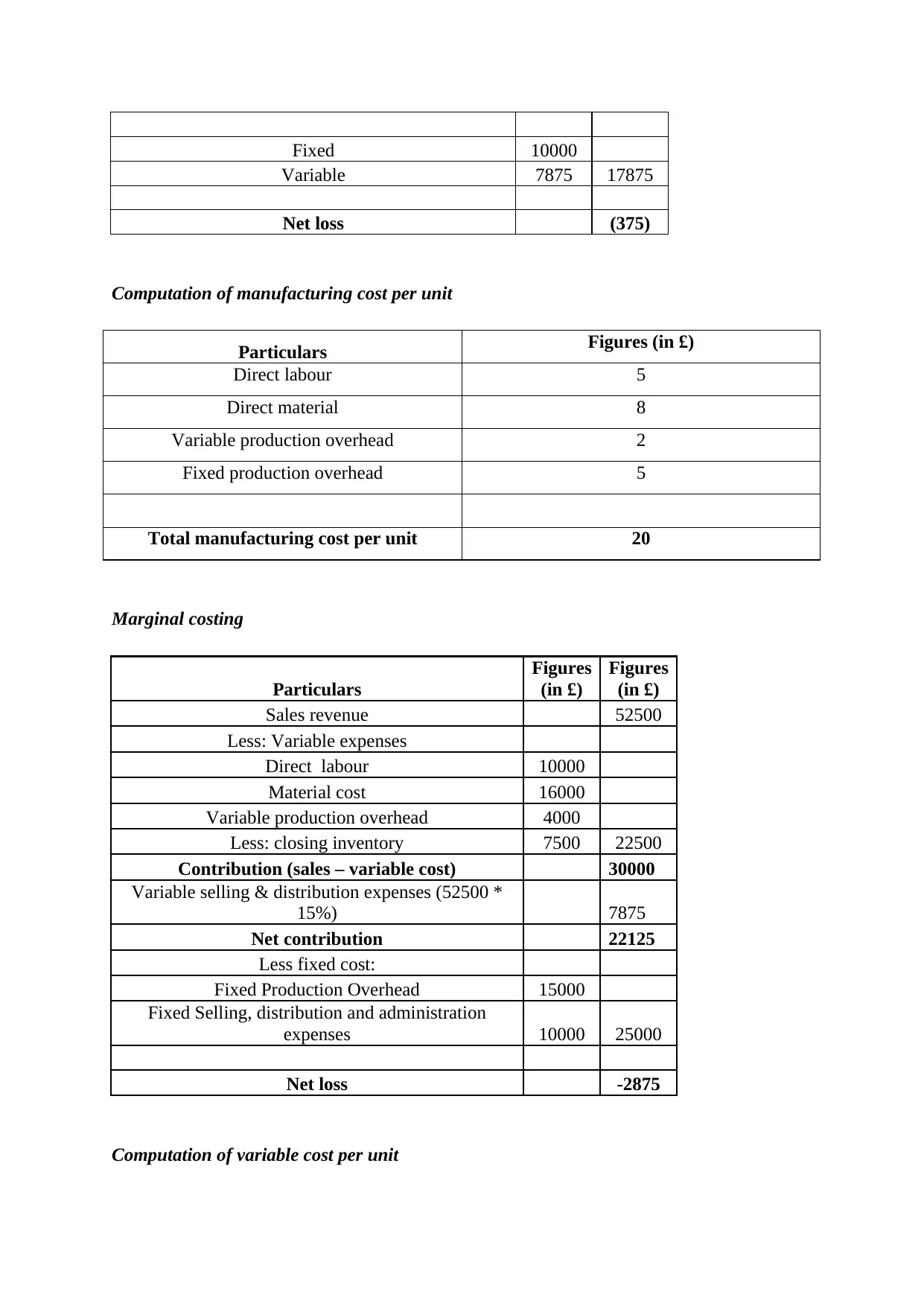
Fixed 10000
Variable 7875 17875
Net loss (375)
Computation of manufacturing cost per unit
Particulars Figures (in £)
Direct labour 5
Direct material 8
Variable production overhead 2
Fixed production overhead 5
Total manufacturing cost per unit 20
Marginal costing
Particulars
Figures
(in £)
Figures
(in £)
Sales revenue 52500
Less: Variable expenses
Direct labour 10000
Material cost 16000
Variable production overhead 4000
Less: closing inventory 7500 22500
Contribution (sales – variable cost) 30000
Variable selling & distribution expenses (52500 *
15%) 7875
Net contribution 22125
Less fixed cost:
Fixed Production Overhead 15000
Fixed Selling, distribution and administration
expenses 10000 25000
Net loss -2875
Computation of variable cost per unit
Variable 7875 17875
Net loss (375)
Computation of manufacturing cost per unit
Particulars Figures (in £)
Direct labour 5
Direct material 8
Variable production overhead 2
Fixed production overhead 5
Total manufacturing cost per unit 20
Marginal costing
Particulars
Figures
(in £)
Figures
(in £)
Sales revenue 52500
Less: Variable expenses
Direct labour 10000
Material cost 16000
Variable production overhead 4000
Less: closing inventory 7500 22500
Contribution (sales – variable cost) 30000
Variable selling & distribution expenses (52500 *
15%) 7875
Net contribution 22125
Less fixed cost:
Fixed Production Overhead 15000
Fixed Selling, distribution and administration
expenses 10000 25000
Net loss -2875
Computation of variable cost per unit
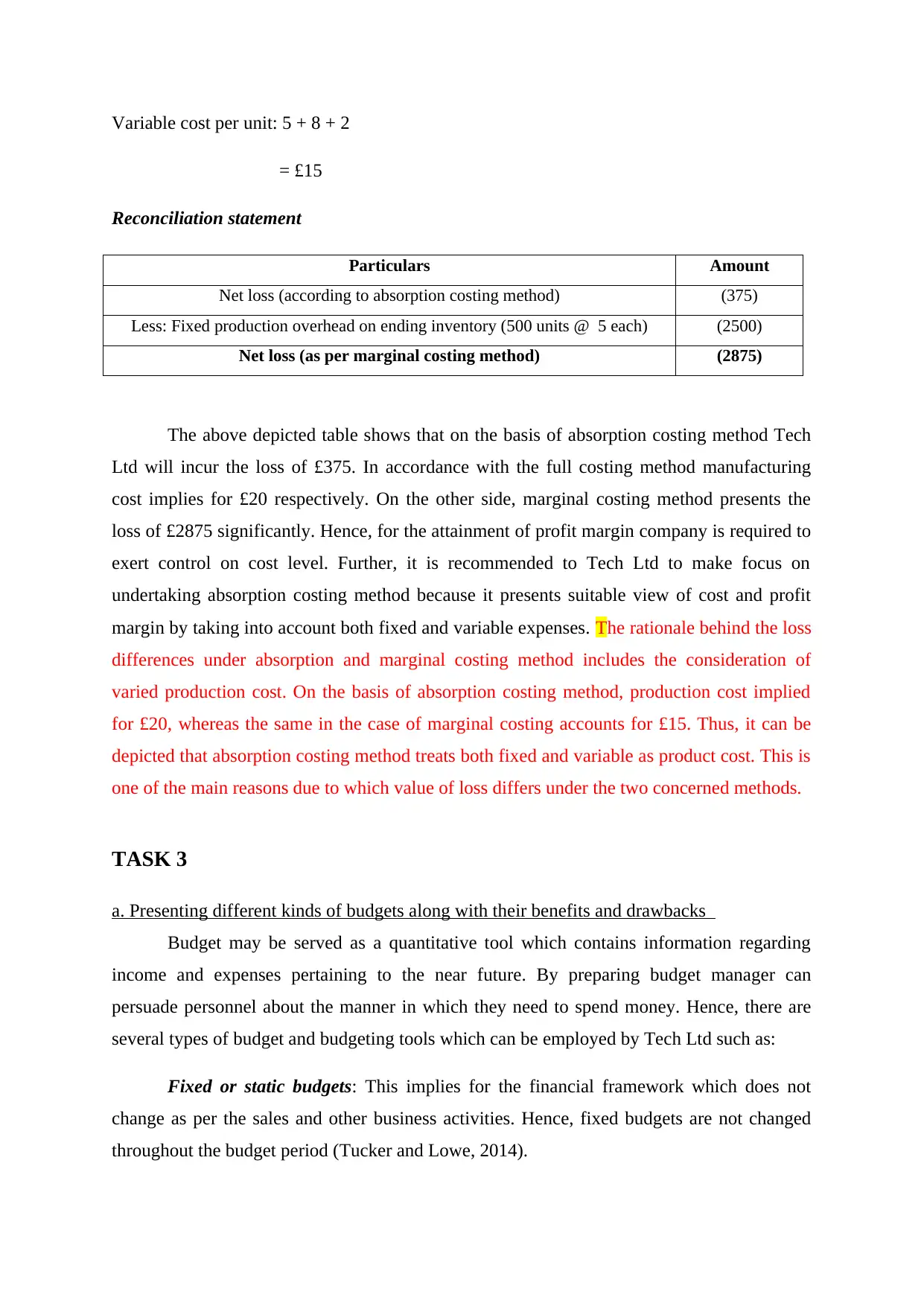
Variable cost per unit: 5 + 8 + 2
= £15
Reconciliation statement
Particulars Amount
Net loss (according to absorption costing method) (375)
Less: Fixed production overhead on ending inventory (500 units @ 5 each) (2500)
Net loss (as per marginal costing method) (2875)
The above depicted table shows that on the basis of absorption costing method Tech
Ltd will incur the loss of £375. In accordance with the full costing method manufacturing
cost implies for £20 respectively. On the other side, marginal costing method presents the
loss of £2875 significantly. Hence, for the attainment of profit margin company is required to
exert control on cost level. Further, it is recommended to Tech Ltd to make focus on
undertaking absorption costing method because it presents suitable view of cost and profit
margin by taking into account both fixed and variable expenses. The rationale behind the loss
differences under absorption and marginal costing method includes the consideration of
varied production cost. On the basis of absorption costing method, production cost implied
for £20, whereas the same in the case of marginal costing accounts for £15. Thus, it can be
depicted that absorption costing method treats both fixed and variable as product cost. This is
one of the main reasons due to which value of loss differs under the two concerned methods.
TASK 3
a. Presenting different kinds of budgets along with their benefits and drawbacks
Budget may be served as a quantitative tool which contains information regarding
income and expenses pertaining to the near future. By preparing budget manager can
persuade personnel about the manner in which they need to spend money. Hence, there are
several types of budget and budgeting tools which can be employed by Tech Ltd such as:
Fixed or static budgets: This implies for the financial framework which does not
change as per the sales and other business activities. Hence, fixed budgets are not changed
throughout the budget period (Tucker and Lowe, 2014).
= £15
Reconciliation statement
Particulars Amount
Net loss (according to absorption costing method) (375)
Less: Fixed production overhead on ending inventory (500 units @ 5 each) (2500)
Net loss (as per marginal costing method) (2875)
The above depicted table shows that on the basis of absorption costing method Tech
Ltd will incur the loss of £375. In accordance with the full costing method manufacturing
cost implies for £20 respectively. On the other side, marginal costing method presents the
loss of £2875 significantly. Hence, for the attainment of profit margin company is required to
exert control on cost level. Further, it is recommended to Tech Ltd to make focus on
undertaking absorption costing method because it presents suitable view of cost and profit
margin by taking into account both fixed and variable expenses. The rationale behind the loss
differences under absorption and marginal costing method includes the consideration of
varied production cost. On the basis of absorption costing method, production cost implied
for £20, whereas the same in the case of marginal costing accounts for £15. Thus, it can be
depicted that absorption costing method treats both fixed and variable as product cost. This is
one of the main reasons due to which value of loss differs under the two concerned methods.
TASK 3
a. Presenting different kinds of budgets along with their benefits and drawbacks
Budget may be served as a quantitative tool which contains information regarding
income and expenses pertaining to the near future. By preparing budget manager can
persuade personnel about the manner in which they need to spend money. Hence, there are
several types of budget and budgeting tools which can be employed by Tech Ltd such as:
Fixed or static budgets: This implies for the financial framework which does not
change as per the sales and other business activities. Hence, fixed budgets are not changed
throughout the budget period (Tucker and Lowe, 2014).
⊘ This is a preview!⊘
Do you want full access?
Subscribe today to unlock all pages.

Trusted by 1+ million students worldwide
1 out of 18
Related Documents
Your All-in-One AI-Powered Toolkit for Academic Success.
+13062052269
info@desklib.com
Available 24*7 on WhatsApp / Email
![[object Object]](/_next/static/media/star-bottom.7253800d.svg)
Unlock your academic potential
Copyright © 2020–2025 A2Z Services. All Rights Reserved. Developed and managed by ZUCOL.





